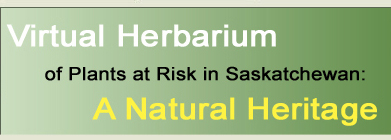
|

|

|

|

|

|

|
|
|
|
|
|
| Oxytropis lambertii var. lambertii Pursh | Species Image Gallery (opens in a new window) |
||||||||||||||||||||||||||||||||||||||
| TAXONOMY | |||||||||||||||||||||||||||||||||||||||
| Family: | Fabaceae | ||||||||||||||||||||||||||||||||||||||
| Genus: | Oxytropis | ||||||||||||||||||||||||||||||||||||||
| Species Synonyms: | Oxytropis involuta (A. Nels.) K. Schum. | ||||||||||||||||||||||||||||||||||||||
| Common Names: | purple locoweed Lambert’s locoweed |
||||||||||||||||||||||||||||||||||||||
| DISTRIBUTION | |||||||||||||||||||||||||||||||||||||||
| Canada: | southeastern Saskatchewan – southern Manitoba | ||||||||||||||||||||||||||||||||||||||
| Saskatchewan: | southeastern Saskatchewan; Souris and Antler River Valleys | ||||||||||||||||||||||||||||||||||||||
| Ecoregion: | Moist Mixed Grassland, Aspen Parkland | ||||||||||||||||||||||||||||||||||||||
| HABITAT | |||||||||||||||||||||||||||||||||||||||
| Saskatchewan: | gravely prairie slopes and summits or river bluffs | ||||||||||||||||||||||||||||||||||||||
| Associaterd species: | green needlegrass, hairy goldenaster, Kentucky bluegrass, phlox, purple milkvetch | ||||||||||||||||||||||||||||||||||||||
| RARITY STATUS | |||||||||||||||||||||||||||||||||||||||
| Provincial
Status According to Harms (2003): |
Vulnerable |
||||||||||||||||||||||||||||||||||||||
| Nature Conservancy Status: | G5 S2 |
||||||||||||||||||||||||||||||||||||||
| Saskatchewan
Species at Risk Status: |
None |
||||||||||||||||||||||||||||||||||||||
| COSEWIC Status: | None |
||||||||||||||||||||||||||||||||||||||
| Purple locoweed is vulnerable in Saskatchewan because it is rare or uncommon and is restricted to a small region of the province. Local population sizes vary and possible threats have been identified for this species. | |||||||||||||||||||||||||||||||||||||||
| SPECIES DESCRIPTION | |||||||||||||||||||||||||||||||||||||||
| Roots: | taproots stout | ||||||||||||||||||||||||||||||||||||||
| Stems: | caudex knobby or branching; stem absent | ||||||||||||||||||||||||||||||||||||||
| Stipules: | fused for more than 4 mm | ||||||||||||||||||||||||||||||||||||||
| Leaves: | odd-pinnate, of two types, principal leaves 10 – 17 cm long, hairs attaching in the middle, hairs long | ||||||||||||||||||||||||||||||||||||||
| Leaflets: | 7 – 19, 0.5 – 4 cm long, linear to elliptic, tip acute to long-tapered | ||||||||||||||||||||||||||||||||||||||
| Inflorescence: | unbranched, 10 – 20-flowered, flowers spreading to erect; inflorescence stalk erect, 5 – 30 cm long | ||||||||||||||||||||||||||||||||||||||
| Flowers: | sepal tube 6 – 7 mm long, long hairy, occasionally with blackish hairs; petals reddish-purple; banner 15 – 25 mm long; wings 12 – 20 mm long, tip square; keel 13 – 19 mm long | ||||||||||||||||||||||||||||||||||||||
| Fruits: | pod sessile or short-stalked, 8 – 15 mm long, ovoid, beak straight to divergent, silky-hairy; seeds 2 mm long, brown, smooth | ||||||||||||||||||||||||||||||||||||||
| |||||||||||||||||||||||||||||||||||||||